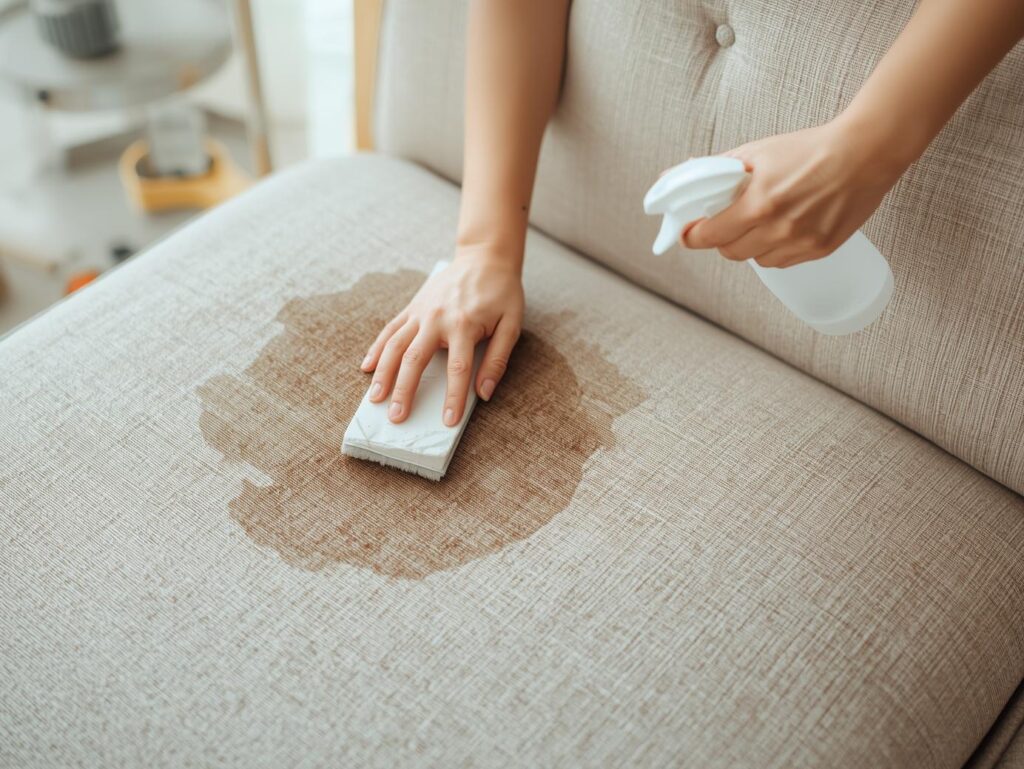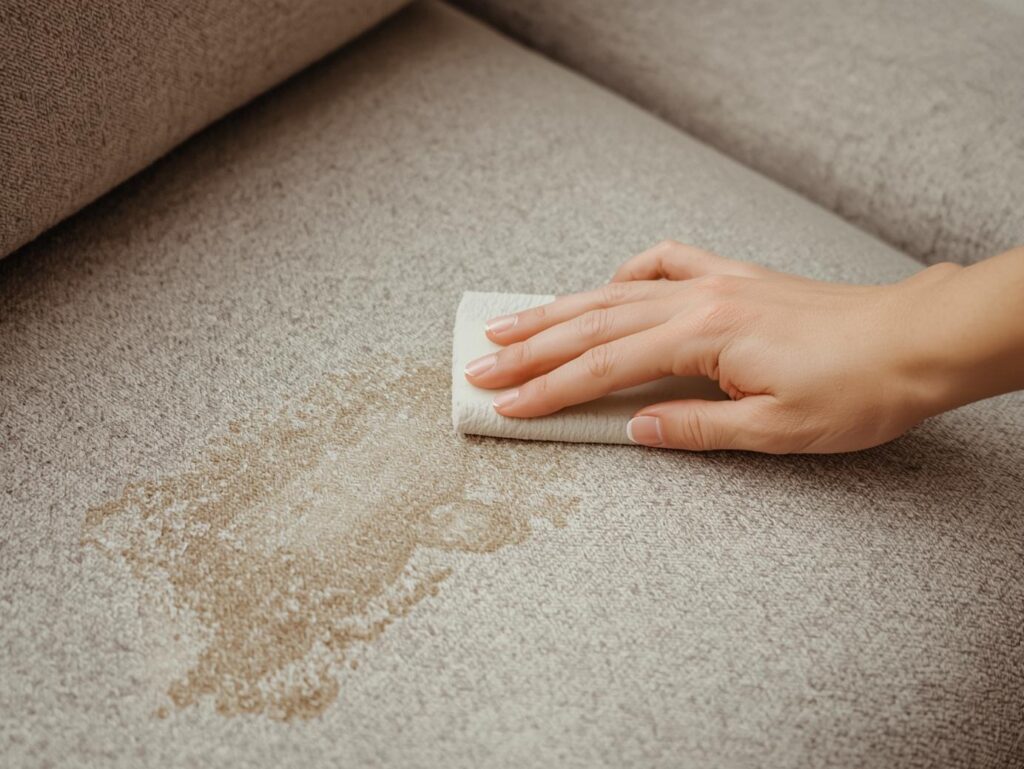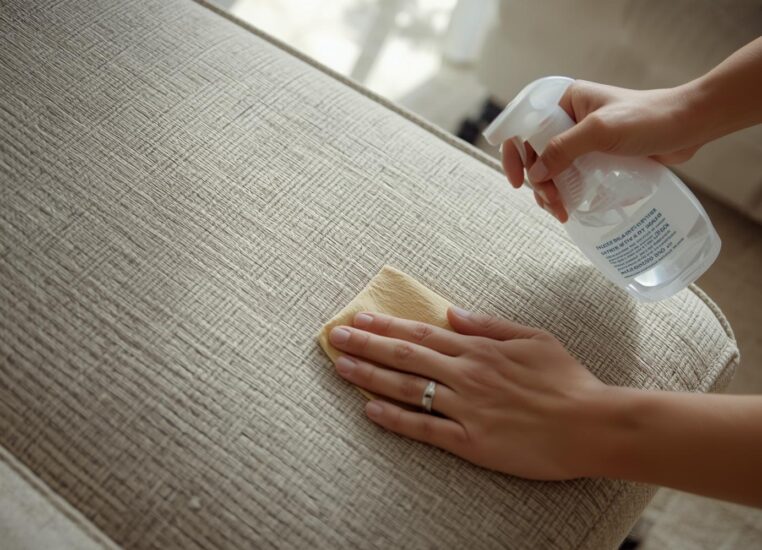A fabric couch is the heart of many living rooms.
It’s where people relax after a long day, binge-watch favorite shows, host friends, and sometimes even sneak in a nap.
But with all that use, it’s no surprise that fabric couches can get dirty fast.
From crumbs and pet hair to spills and mysterious stains, keeping a fabric couch clean can feel like a never-ending battle.
The good news? With the right approach, it’s totally manageable.
This post covers everything needed to keep a fabric couch looking, smelling, and feeling fresh.

Why Regular Couch Cleaning Matters
A clean couch isn’t just about appearances. Here’s why it’s worth the effort:
|
Benefit |
Explanation |
|---|---|
|
Better Air Quality |
Dust, pollen, and pet dander collect in fabric and can affect indoor air. |
|
Longer Lifespan |
Regular cleaning prevents dirt from wearing down fibers. |
|
Fewer Allergens |
Removing dust mites and allergens helps everyone breathe easier. |
|
Improved Comfort |
A clean couch just feels better to sit on. |
|
Odor Control |
Cleaning removes smells from pets, food, and daily use. |
Couch Fabric Types
It’s important to know what kind of fabric the couch is made of. Different materials need different care.
|
Fabric Type |
Common Examples |
Cleaning Notes |
|---|---|---|
|
Synthetic |
Polyester, nylon, acrylic |
Durable, usually easy to clean |
|
Natural |
Cotton, linen, wool |
Can be delicate, may shrink |
|
Blends |
Poly-cotton, linen-blend |
Check both fabric types for care |
|
Microfiber |
Polyester micro-weave |
Repels stains, easy to clean |
|
Velvet |
Cotton or synthetic pile |
Needs gentle cleaning |
|
Chenille |
Woven with raised yarns |
Vacuum gently, avoid soaking |
Tip: Always check the manufacturer’s tag for cleaning codes.
Decoding Couch Cleaning Codes
Most couches have a tag with a cleaning code. Here’s what they mean:
|
Code |
What It Means |
Best Cleaning Method |
|---|---|---|
|
W |
Water-based cleaner |
Safe to use water and mild soap |
|
S |
Solvent-based cleaner |
Use dry-cleaning solvent, no water |
|
WS |
Water or solvent |
Either method is safe |
|
X |
Vacuum only |
No water or solvent, just vacuum |

Essential Tools and Supplies
Having the right tools makes cleaning easier and more effective.
|
Tool/Supply |
Purpose |
|---|---|
|
Vacuum with upholstery attachment |
Removes dust, crumbs, pet hair |
|
Lint roller |
Picks up hair and fuzz |
|
Soft-bristled brush |
Loosens dirt and lifts nap |
|
Spray bottle |
Applies cleaning solutions evenly |
|
White cloths or sponges |
Blotting and wiping stains |
|
Mild dish soap |
Gentle cleaning |
|
White vinegar |
Deodorizing and stain removal |
|
Baking soda |
Odor removal and gentle scrubbing |
|
Rubbing alcohol |
Spot cleaning (for S code fabrics) |
|
Commercial upholstery cleaner |
For tough stains (check compatibility) |
Step-by-Step: Routine Cleaning for Fabric Couches
1. Remove Loose Debris
- Take off all cushions and pillows.
- Use a vacuum with an upholstery attachment to clean all surfaces, including under cushions and in crevices.
- Use a lint roller for pet hair or stubborn fuzz.
2. Brush the Fabric
- Use a soft-bristled brush to gently lift dirt and restore the fabric’s nap.
- Brush in the direction of the fabric weave.
3. Deodorize with Baking Soda
- Sprinkle a generous layer of baking soda over the entire couch.
- Let it sit for 20–30 minutes to absorb odors.
- Vacuum thoroughly to remove all baking soda.
Spot Cleaning Stains
Accidents happen. Here’s how to tackle common stains:
|
Stain Type |
First Step |
Cleaning Solution |
Blot or Scrub? |
|---|---|---|---|
|
Food/Drink |
Blot up excess with a white cloth |
Mix mild dish soap with water |
Blot |
|
Grease/Oil |
Sprinkle with baking soda, let sit, vacuum |
Dab with dish soap solution |
Blot |
|
Ink |
Blot with rubbing alcohol on a cloth |
Rubbing alcohol |
Blot |
|
Pet accidents |
Blot up moisture, sprinkle baking soda |
Vinegar and water mix |
Blot |
|
Mud |
Let dry, vacuum up |
Mild soap and water |
Blot |
General Rule: Always test any cleaner on a hidden area first.
DIY Cleaning Solutions
Here are a few safe, effective homemade cleaners:
|
Solution |
Ingredients |
Best For |
|---|---|---|
|
Mild Soap Mix |
1 tsp dish soap + 2 cups warm water |
General stains, routine cleaning |
|
Vinegar Spray |
1 cup water + 1/2 cup white vinegar |
Deodorizing, light stains |
|
Alcohol Spot Cleaner |
Rubbing alcohol on a cloth |
Ink, marker, sticky spots |
|
Baking Soda Paste |
Baking soda + a little water |
Grease, stubborn stains |
Deep Cleaning a Fabric Couch
Every few months, a deeper clean helps keep the couch in top shape.
1. Check the Tag
- Make sure the fabric can handle water or solvent cleaning.
2. Prepare the Cleaning Solution
- For W or WS codes: Mix a few drops of mild dish soap in a bowl of warm water.
- For S code: Use a solvent-based upholstery cleaner or rubbing alcohol.
3. Clean the Couch
- Dip a white cloth or sponge in the solution, wring out excess liquid.
- Gently blot (don’t rub) the fabric, working in small sections.
- Rinse the cloth frequently and change the solution if it gets dirty.
4. Rinse (If Water-Safe)
- Wipe the couch with a clean, damp cloth to remove soap residue.
5. Dry Thoroughly
- Blot with a dry towel.
- Let the couch air dry completely before replacing cushions.
Cleaning Removable Cushion Covers
If the couch has removable, machine-washable covers:
|
Step |
Instructions |
|---|---|
|
1 |
Check the tag for washing instructions. |
|
2 |
Zip covers closed to prevent damage. |
|
3 |
Wash on a gentle cycle with mild detergent. |
|
4 |
Air dry to prevent shrinking. |
|
5 |
Replace covers only when completely dry. |
Dealing with Odors
Fabric couches can trap smells from pets, food, and daily life. Here’s how to freshen things up:
Baking Soda Method
- Sprinkle baking soda over the couch, let sit for 30 minutes, then vacuum.
Vinegar Spray
- Lightly mist the couch with a mix of water and white vinegar.
- Let air dry; the vinegar smell will fade, taking odors with it.
Sun and Air
- If possible, move cushions outside on a dry, breezy day.
- Sunlight and fresh air help kill bacteria and remove odors.
Pet Hair and Dander
Pets are lovable, but their hair and dander can be a challenge.
|
Tool |
How to Use |
|---|---|
|
Lint roller |
Roll over fabric to pick up hair |
|
Rubber glove |
Dampen glove, run hand over couch to gather hair |
|
Vacuum with pet attachment |
Use regularly for best results |
|
Fabric brush |
Brush in one direction to lift hair |
Preventing Future Stains and Dirt
|
Tip |
Benefit |
|---|---|
|
Use washable throws or slipcovers |
Easy to clean, protects fabric |
|
No eating on the couch |
Reduces crumbs and spills |
|
Train pets to stay off furniture |
Less hair and dander |
|
Vacuum weekly |
Prevents buildup |
|
Treat stains immediately |
Easier to remove when fresh |
Troubleshooting Common Couch Cleaning Problems
|
Problem |
Possible Cause |
Solution |
|---|---|---|
|
Water rings |
Too much moisture, slow drying |
Blot with dry towel, use fan to speed drying |
|
Stiff fabric after cleaning |
Soap residue |
Wipe with damp cloth, let air dry |
|
Lingering odors |
Deep-set smells |
Repeat baking soda or vinegar treatment |
|
Color fading |
Harsh cleaners, sun exposure |
Use gentle products, keep out of direct sunlight |
|
Shrinking covers |
Hot water or dryer |
Always air dry, use cold water |
Cleaning Special Fabrics
Microfiber
- Vacuum regularly.
- For stains, use a small amount of rubbing alcohol on a white cloth.
- Brush with a soft brush to restore texture.
Velvet
- Vacuum with a soft brush attachment.
- Blot stains with a damp cloth, avoid soaking.
- Use a steamer to lift the nap if needed.
Linen
- Vacuum gently.
- Spot clean with mild soap and water.
- Avoid over-wetting.
Professional Cleaning: When to Call in the Pros
Sometimes, a professional cleaning is the best option:
- Large, set-in stains that won’t budge.
- Mold or mildew issues.
- Delicate or antique fabrics.
- Annual deep cleaning for high-use couches.
Couch Cleaning Schedule

|
Task |
Frequency |
|---|---|
|
Vacuum and brush |
Weekly |
|
Spot clean stains |
As needed |
|
Deodorize with baking soda |
Monthly |
|
Deep clean |
Every 3–6 months |
|
Wash removable covers |
Every 3–6 months or as needed |
|
Professional cleaning |
Annually or as needed |
Frequently Asked Questions
Can I use a steam cleaner on my fabric couch?
Only if the manufacturer’s tag says it’s safe. Steam can damage some fabrics or cause shrinkage.
What’s the best way to dry a wet couch?
Blot with towels, use fans, and open windows for airflow. Avoid direct heat, which can shrink fabric.
How do I get rid of old, set-in stains?
Try a baking soda paste or a commercial upholstery cleaner. For tough stains, professional cleaning may be needed.
Is it safe to use vinegar on all fabrics?
Vinegar is safe for most, but always test on a hidden spot first. Avoid on silk or delicate fabrics.
Quick Tips for a Cleaner Couch
- Rotate cushions regularly for even wear.
- Keep pets’ nails trimmed to avoid snags.
- Address spills and stains right away.
- Use armrest covers or throws in high-use areas.
- Keep a small cleaning kit nearby for quick cleanups.
Fun Facts About Fabric Couches
- The average couch lasts 7–15 years with proper care.
- A couch can harbor millions of dust mites if not cleaned regularly.
- Some modern fabrics are treated to resist stains and odors.
- The word “sofa” comes from the Arabic “suffah,” meaning a bench covered with cushions.
Final Thoughts
A fabric couch is an investment in comfort and style. With regular care, the right cleaning methods, and a few preventative habits, it’s easy to keep a couch looking and feeling fresh for years. Whether dealing with everyday dust, a sudden spill, or just wanting to freshen things up, these tips and tricks make couch cleaning simple and stress-free. So grab a vacuum, a soft cloth, and a little baking soda, and enjoy a cleaner, cozier living room.










